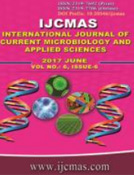


 National Academy of Agricultural Sciences (NAAS)
National Academy of Agricultural Sciences (NAAS)

|
PRINT ISSN : 2319-7692
Online ISSN : 2319-7706 Issues : 12 per year Publisher : Excellent Publishers Email : editorijcmas@gmail.com / submit@ijcmas.com Editor-in-chief: Dr.M.Prakash Index Copernicus ICV 2018: 95.39 NAAS RATING 2020: 5.38 |
Blood stream infections can lead to life threatening sepsis and require immediate antimicrobial treatment. Blood culture is an essential tool for the investigation of clinically suspected sepsis. The present study has been conducted to describe the profile of bacterial isolates from blood cultures and their antibiotic resistance. This is prospective study of 273 blood cultures, collected from clinically suspected cases of bacteraemia studied over a period of five months in a tertiary care hospital in Ujjain, M.P. The isolates were identified by standard biochemical tests and antimicrobial resistance patterns were determined by CLSI guidelines. Blood cultures were positive in 70 (25.6%) patients by BacT alert system. Gram positive organism accounted for 51.4% cases; most common being Staphylococcus aureus (47.3%) followed by Enterococci (4.3%), Of the Gram negative isolates, Klebsiella spp (14.3%) was the most common followed by Pseudomonas spp. (8.6%). Candida albicans was isolated in 2.8% cases. Gram positive isolates showed high resistance to penicillin (81.8%) and least resistance to linezolid (18.2%). Gram negative isolates were found high resistance to amoxy-clav (90%) and least resistance to Imipenem (20%). This study provides information on antibiotic resistance of blood isolates. It may be a useful guide for physicians initiating empiric therapy and will help in formulation of antibiotic therapy strategy.
 |
 |
 |
 |
 |